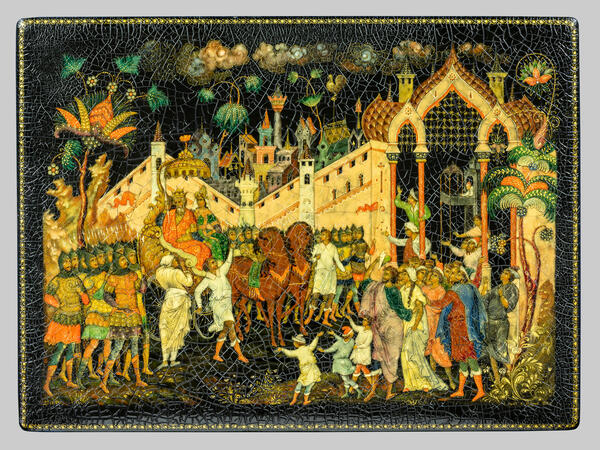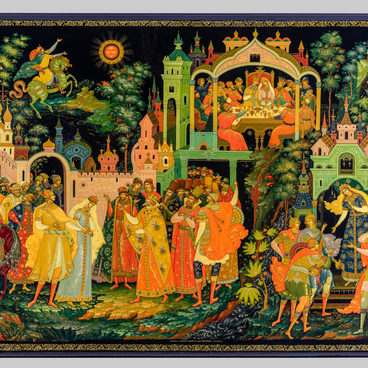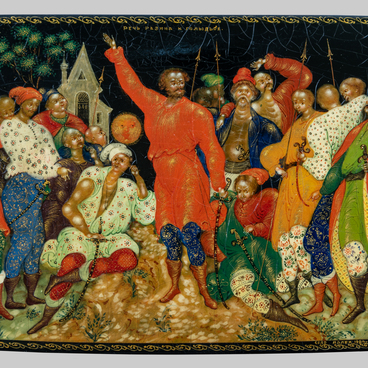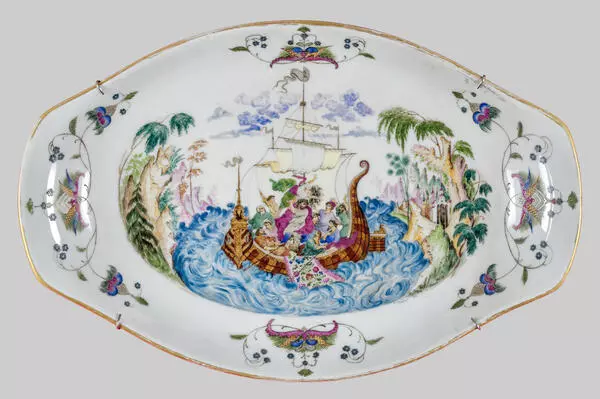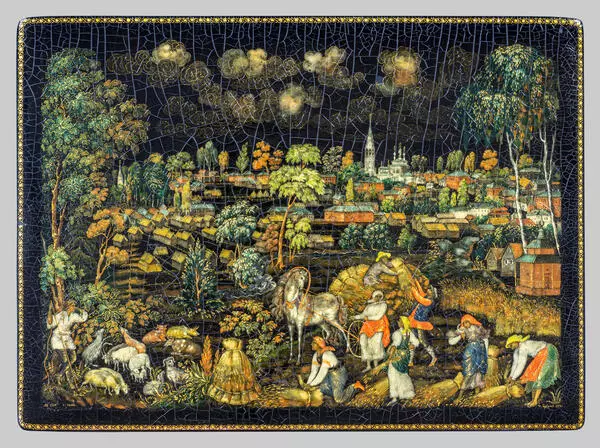Ivan Bakanov created ‘The Tale of the Golden Cockerel’ composition in 1934. Until 1918, he was painting icons, and he was considered the most skillful icon painted in Palekh, possessing profound knowledge of icon painting traditions. He started applying his skills to lacquer miniature in 1924. Many of his artworks, including ‘The Tale of the Golden Cockerel’, are considered classics of the Palekh craftsmanship.
The artist based this composition on a icon plot he was intimately familiar with — Palm Sunday. He arranged the characters in accordance with that plot — a group of running children is quite reminiscent of the latter.
The multi-figured composition is clearly understood, and its details are well-coordinated. Tsar Dadon and Tsaritsa of Shamakhan are riding in the ornate chariot. Her green dress and his red attire combine into a pronounced spotlight of color. A wise man from the East in pale clothes is standing beside them. The Tsar is followed by his army, and they are greeted by the people who are rushing out on the street.
The artist created an atmosphere of a busy town well depicting the crowd of people. At the same time, he managed to avoid detail overload and unnecessary fussiness. Smooth majestic rhythm of the people’s movement contasts with sharp angles of the city walls. The contrasts these lines provide create the much-needed dynamic feel.
The artist opted out of the sarcastic overtones present in Pushkin’s fairytale. Instead, he created an image of that fairytale world with heroes and architecture of its own. Intricate buildings outside the city wall are full of wondrous details. Small ornate towers, porches, minarets, and fabrics forming canopies between architectural structures look like they would fit in with the architectural style of Palekh icons.
The pink wall itself, with all its minor details, looks quite natural. The artist used very fine color variations to paint it. With these gentle tonal shifts, the wall doesn’t look quite as massive and immovable.
Ivan Bakanov is an unparalleled expert of color. The paints he used were almost as clear as medieval enamels. He painted the ocher-golden hills with the most delicate, shimmering fusions of color in a unique multilayer painting technique originating in Palekh. With these fusions, the artist blended the darker tones with the lighter ones. At the same time, he preserved the clarity of the color spot.
The artist based this composition on a icon plot he was intimately familiar with — Palm Sunday. He arranged the characters in accordance with that plot — a group of running children is quite reminiscent of the latter.
The multi-figured composition is clearly understood, and its details are well-coordinated. Tsar Dadon and Tsaritsa of Shamakhan are riding in the ornate chariot. Her green dress and his red attire combine into a pronounced spotlight of color. A wise man from the East in pale clothes is standing beside them. The Tsar is followed by his army, and they are greeted by the people who are rushing out on the street.
The artist created an atmosphere of a busy town well depicting the crowd of people. At the same time, he managed to avoid detail overload and unnecessary fussiness. Smooth majestic rhythm of the people’s movement contasts with sharp angles of the city walls. The contrasts these lines provide create the much-needed dynamic feel.
The artist opted out of the sarcastic overtones present in Pushkin’s fairytale. Instead, he created an image of that fairytale world with heroes and architecture of its own. Intricate buildings outside the city wall are full of wondrous details. Small ornate towers, porches, minarets, and fabrics forming canopies between architectural structures look like they would fit in with the architectural style of Palekh icons.
The pink wall itself, with all its minor details, looks quite natural. The artist used very fine color variations to paint it. With these gentle tonal shifts, the wall doesn’t look quite as massive and immovable.
Ivan Bakanov is an unparalleled expert of color. The paints he used were almost as clear as medieval enamels. He painted the ocher-golden hills with the most delicate, shimmering fusions of color in a unique multilayer painting technique originating in Palekh. With these fusions, the artist blended the darker tones with the lighter ones. At the same time, he preserved the clarity of the color spot.

